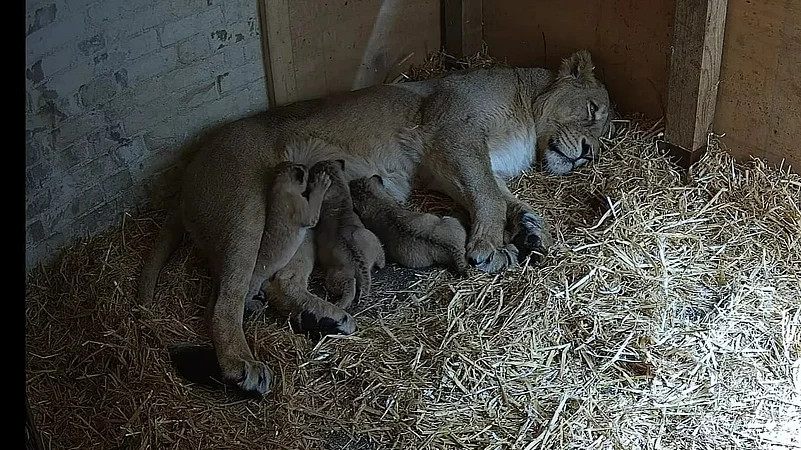London Zoo welcomes the arrival of three endangered Asiatic lion cubs, born to seven-year-old mother Arya and 14-year-old father Bhanu on March 13th. Zookeepers carefully monitored Arya's six-hour labor using hidden cameras, ensuring a safe delivery for the lioness and her cubs.
The birth of the cubs marks a significant milestone for the conservation breeding program, according to Kathryn Sanders, head big cat keeper at the zoo. Sanders expressed excitement over the new additions to the endangered Asiatic lion population, especially considering their declining numbers in the wild.
Through the zoo's "cubcam," footage captured Arya giving birth and nurturing her newborns, providing valuable insights into the early stages of their development. Since their birth, zookeepers have observed the cubs' milestones, including their first steps, while prioritizing bonding time with their mother.
Sanders emphasized Arya's maternal instincts, describing her as a devoted mother to her three cubs. The newborns have remained inside their custom-built den, gradually reaching developmental milestones such as opening their eyes after ten days.
While the cubs continue to spend time indoors with Arya, zookeepers anticipate their eventual exploration of the outdoor habitat as the weather improves. The cubs' gender will be confirmed during their first vet check and vaccinations, scheduled when they are 10 to 11 weeks old.
What is the Asiatic Lion?
The Asiatic lion, distinct from its African counterpart, possesses unique morphological features and faces distinct conservation challenges. Slightly smaller in size, with adult males weighing between 160 to 190 kg and females between 110 to 120 kg, these majestic creatures stand at about 3.5 ft (110 cm) tall at the shoulders. Their fur, ranging from ruddy-tawny to sandy or buff-grey, often displays a silvery sheen under certain lighting conditions, with black speckles adding to their striking appearance. Asiatic lions feature a longitudinal fold of skin along their bellies, a characteristic rarely seen in African lions. Males exhibit moderate mane growth, leaving their ears consistently visible.
Despite their regal stature, Asiatic lions confront various threats to their survival. Poaching and habitat fragmentation pose significant challenges, exacerbated by the presence of major roads and a railway track traversing the Gir Protected Area (PA) in Gujarat, India. Pilgrimage sites within the PA attract large numbers of visitors, leading to potential conflicts between humans and lions, particularly as the lion population expands beyond the PA boundaries.
The concentration of the lion population in a single location raises concerns about genetic inbreeding, highlighting the need for conservation efforts to ensure their long-term viability.

Historically, Asiatic lions roamed across a wider range, extending up to West Bengal in the east and Rewa in Madhya Pradesh, central India. But now limited to the Gir Forest in Gujarat, India, the species face significant threats due to habitat loss and fragmentation. With only 600 to 700 individuals remaining in the wild, each new addition to the population is crucial for their survival.
The compact tract of dry deciduous forest and open grassy scrublands in the southwestern part of the Saurashtra region of Gujarat now hosts the last surviving population of Asiatic lions. Conservation initiatives are crucial to safeguarding this iconic species and preserving its unique genetic heritage for future generations.





























